Cape Charles Elementary
Introduction
Author-Uploaded Audio
Cape Charles Elementary read by Dr. Paul E. Bibbins, Jr.
Text-to-speech Audio
The term "the hump" is a fixture in Cape Charles' vocabulary. The phrase describes a former vehicle bridge spanning the railroad tracks that now leads tourists and retirees to the harbor and the community of Bay Creek. Driving or walking over the hump, you will see a unique brick structure to your right. This building, Cape Charles Elementary School, was once a vibrant hub of learning for African American students.
In 1928, the African American community's push for a public school started to become a reality. Cape Charles purchased 2.5 acres of land from the Pennsylvania Railroad and acquired a seed grant from the Rosenwald Fund to help build the school. The Rosenwald School Building Project, a partnership between Booker T. Washington and Julius Rosenwald, helped realize a public school for the African American children in Cape Charles, but the community made the dream a reality. Individuals and community organizations, including the First Baptist Church and the Cape Charles Public School League, donated money, supplies, and labor to construct and maintain the school. Cape Charles Elementary School educated African American students from 1929 until 1966, when Northampton County Public Schools were consolidated before integration in 1970. Currently, the Cape Charles Rosenwald School Restoration Initiative owns the school, with hopes to preserve the building and history of the school and "engage and enrich the community, promote cultural awareness and understanding, and support self-sufficiency and economic mobility."[1]
Images
A historical marker dedicated in 2011 proudly welcomes onlookers to the Cape Charles Elementary School grounds in June 2022. (Allison Blakeman)
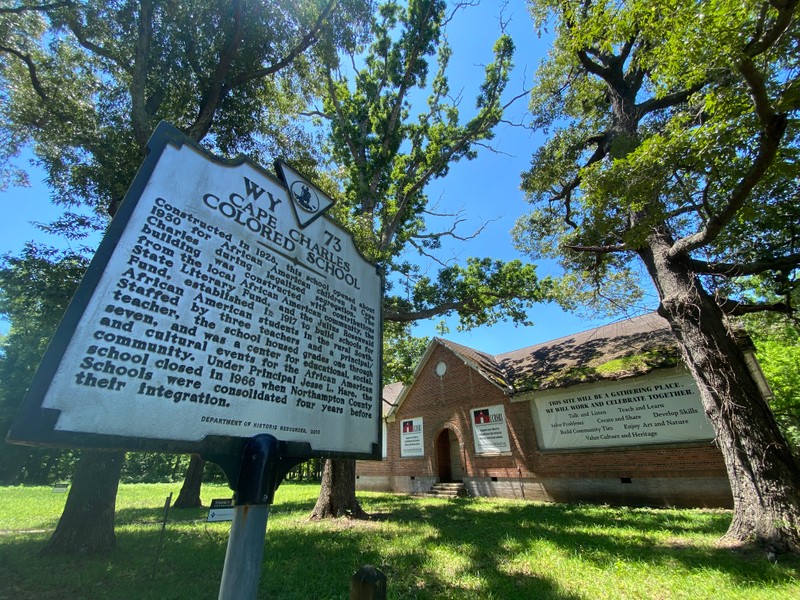
Cape Charles Elementary School stands after it was first constructed in 1929. (The Cape Charles Rosenwald School Restoration Initiative)
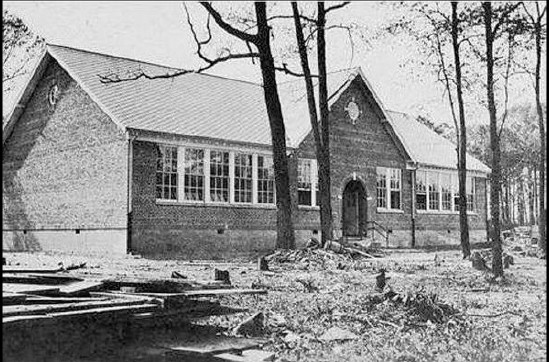
This colorful postcard of the then-new vehicle bridge, or the hump, shows what African American students had to climb every day to reach their school. (Cape Charles Museum and Welcome Center)
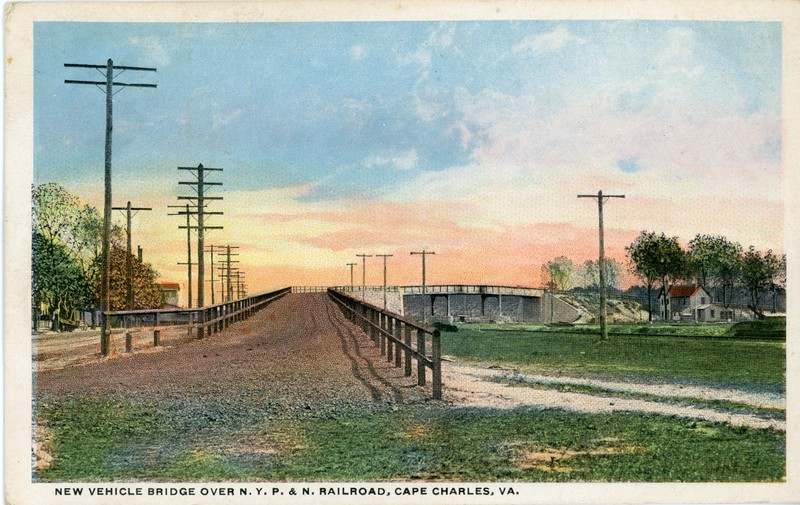
Teacher John Nottingham is pictured with some of his students sometime around 1958. (The Cape Charles Rosenwald School Restoration Initiative)
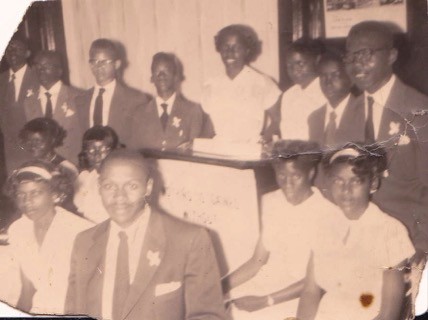
Dianne Davis recites her Cape Charles Elementary School class’ history in 1962. (The Cape Charles Rosenwald School Restoration Initiative)
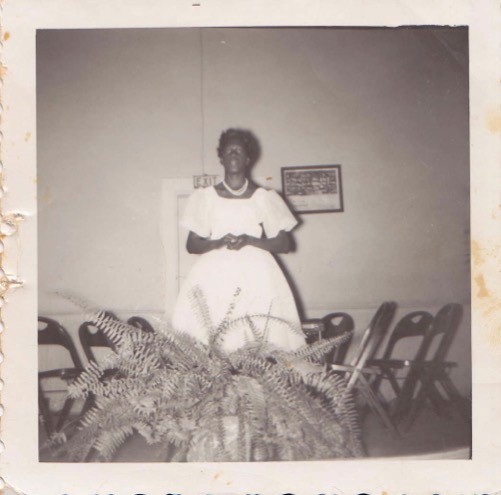
Cape Charles Elementary School students don their best dresses for their Mayday procession around 1960. (The Cape Charles Rosenwald School Restoration Initiative)
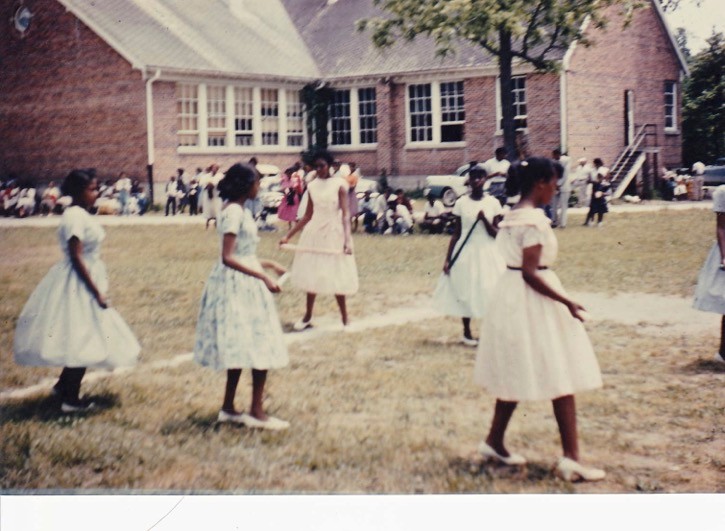
The Mayday King and Queen sit with their court at a Cape Charles Elementary School Mayday celebration. (Photograph courtesy The Cape Charles Rosenwald School Restoration Initiative)
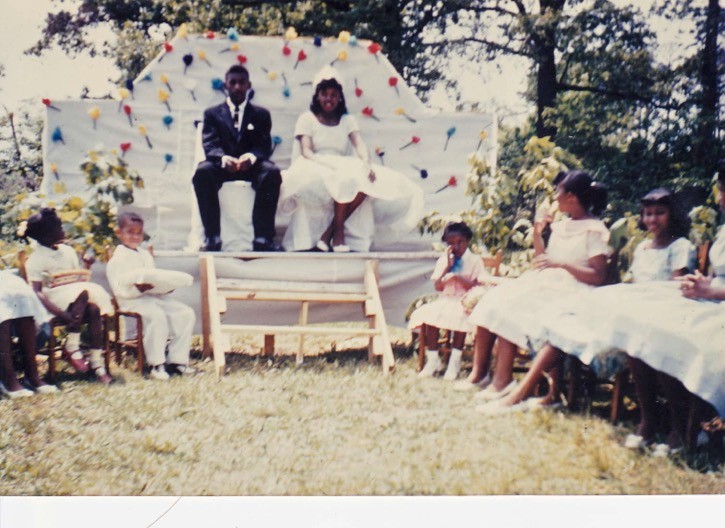
Once where dances were held and plays put on, the auditorium of Cape Charles Elementary School awaits restoration to its former glory. (Virginia Department of Historic Resources)
.jpg)
Backstory and Context
Text-to-speech Audio
All children have memories from their school days, but when you are told you cannot attend school in town because of the color of your skin, the memories can stir mixed emotions. Valentine Elliott Evans, who started attending Cape Charles Elementary School in the third grade, fondly recalls the exercise, plays, devotions, and Maydays, noting, "People were very community minded."[2] Many students recall walking to school in "rain, snow, good weather" over the hump and climbing up the many steps to reach the top of the railroad bridge; however, some former students have stronger feelings about their time at Cape Charles Elementary School.[3] Melvin W. Williams, Jr., the first African American to make Chief in the rating of Aviation Survivalman in the U.S. Coast Guard before retiring as Chief Warrant Officer, wonders how the burning garbage in the dump behind the school building has affected his, fellow classmates', and teachers' health. He feels that the school over the hump "was really an insult [...] to my race, but we had nowhere else to go."[4] Dianne Davis, a retired educator who attended Cape Charles Elementary School, states she "did not feel that our [...] education was inferior," but that students at the segregated school did not have an equal education compared to Cape Charles High School.[5] Davis said she never could understand why Cape Charles Elementary received the hand-me-down books from the white school and that "we knew that we had the older books" while Cape Charles High School got new books.[6] Vivian Spady Dent, a retired teacher and Northampton High School Athletic Hall of Fame inductee who also attended Cape Charles Elementary School, recalls that "Ninety-nine percent [of the photographs in textbooks] were [...] white features, [...] but [...] we were just happy to get the book [...] It wasn't until the later years, high school and what have you, that you begin to look at Black, white, and why."[7]
One thing former students agree upon is how wonderful their teachers at Cape Charles Elementary School were, even if they were tough. The teachers not only prepared them for their continued education at Northampton County High School, the county's only secondary school for African Americans, but also for life. The school educated children (Grade 1-7) and produced teachers, politicians, professional sportsmen, pastors, nurses, and other upstanding citizens who have contributed to our society.
Former student Thomasine Jacobs remembers that "when it comes to anything basic we had the best education ever. The teachers were determined to make sure that every student got what we needed [...] and don't play because if you do your mom would know about it before you even got home."[8] The teachers and principal at Cape Charles Elementary School garnered respect and a higher social standing. School and church in the African American community in Cape Charles were very intertwined. The principal of the school might address the congregation of one of the community's churches, and the churches often held fundraisers and school events.
The memories of Maydays long past, sock hops in the auditorium, and morning devotionals should be remembered alongside the hand-me-down textbooks, dump behind the school, and institutionalized racism. Cape Charles must reckon its "golden" railroad and ferry days alongside its history of segregated businesses, schools, and communities. With the town's resurgence as a summer vacation destination, members of the deep-rooted African American community are once again being marginalized and pushed out due to rising housing costs and high taxes.
The Cape Charles Rosenwald School Restoration Initiative (CCRSRI) purchased Cape Charles Elementary School in 2019. The school will be reopened with spaces and exhibits that honor its history, alumni, and community. The organization plans to balance workforce development opportunities, multigenerational educational, cultural enrichment, civic, and community activities with much needed event space. The building will feature a certified commercial kitchen, director’s office, conference room, and bathrooms. The site will have ample parking, handicap accessible walkways and ramps, outdoor festival grounds, and open space with walking trails. CCRSRI’s goal is to reduce long-standing barriers to educational opportunities and offer quality of life experiences that can help break the cycle of generational poverty.
Organizations and initiatives such as CCRSRI and the Invisible History Committee are uncovering the repressed and undocumented history and contributions of African Americans in Cape Charles. With a spotlight on this important part of the town's history, it is hoped that the Cape Charles community will see the necessity of saving not only the school from disrepair but also building back the vibrant African American community that was instrumental in the creation of the town and remains part of its cultural fabric.
Sources
[1] "The Cape Charles Rosenwald School Restoration Initiative," CCRSRI, Inc. https://ccrosenwaldschool.org.
[2] Valentine Elliott Evans interviewed by Fiameta “Metty” Vargas Pellicer (May 20, 2021), Oral History Interview for the Cape Charles Rotary Club Invisible History Project.
[3] Richard Cornell Press, Sr. interviewed by Fiameta “Metty” Vargas Pellicer (February 8, 2022), Oral History Interview for the Cape Charles Rotary Club Invisible History Project.
[4] Melvin W. Williams, Jr., US Coast Guard CWO, interviewed by Fiameta “Metty” Vargas Pellicer (December 2, 2021), Oral History Interview for the Cape Charles Rotary Club Invisible History Project.
[5] Stefanie Jackson, “Community Leader Dianne Davis Recalls Growing Up in Segregated Cape Charles,” Eastern Shore Post, February 10, 2022, https://easternshorepost.com/2022/02/10/community-leader-dianne-davis-recalls-growing-up-in-segregated-cape-charles/.
[6] Jackson, “Community Leader Dianne Davis.”
[7] Vivian Dent interviewed by Jennifer Cagle and Linda Schulz (November 15, 2013), Oral History Interview for the Cape Charles Rosenwald School Restoration Initiative.
[8] The Jacobs Family interviewed by Linda Schulz (No Date), Oral History Interview for the Cape Charles Rosenwald School Restoration Initiative.
Allison Blakeman, June 2022
The Cape Charles Rosenwald School Restoration Initiative; Picture of School First Constrcuted
Cape Charles Museum and Welcome Center; 1414
The Cape Charles Rosenwald School Restoration Initiative; RW18-23 CCE Teachers John Nottingham c.1958
The Cape Charles Rosenwald School Restoration Initiative; RW18-26A Dianne Davis CCE class history 1962
The Cape Charles Rosenwald School Restoration Initiative; RW18-33 CCE May Day procession c. 1960
The Cape Charles Rosenwald School Restoration Initiative; RW18-36 CCE May Day king and queen c.1960
Virginia Department of Historic Resources, Cape Charles Rosenwald School, 182-0003, E. H. Lipford, 2019; 182-0003_Cape_Charles_Colored_School_2019_interior (2)
